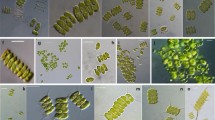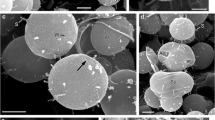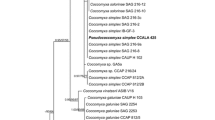Abstract
The aim of this study was to assess the phylogenetic relationships, ecology and ecophysiological characteristics of the dominant planktic algae in ice-covered lakes on James Ross Island (northeastern Antarctic Peninsula). Phylogenetic analyses of 18S rDNA together with analysis of ITS2 rDNA secondary structure and cell morphology revealed that the two strains belong to one species of the genus Monoraphidium (Chlorophyta, Sphaeropleales, Selenastraceae) that should be described as new in future. Immotile green algae are thus apparently capable to become the dominant primary producer in the extreme environment of Antarctic lakes with extensive ice-cover. The strains grew in a wide temperature range, but the growth was inhibited at temperatures above 20 °C, indicating their adaptation to low temperature. Preferences for low irradiances reflected the light conditions in their original habitat. Together with relatively high growth rates (0.4–0.5 day−1) and unprecedently high content of polyunsaturated fatty acids (PUFA, more than 70% of total fatty acids), it makes these isolates interesting candidates for biotechnological applications.






Similar content being viewed by others
References
Allen MM (1968) Simple conditions for growth of unicellular blue-green algae on plates. J Phycol 4:1–4
Altschul SF, Gish W, Miller W, Myers EW, Lipman DJ (1990) Basic local alignment search tool. J Mol Biol 215:403–410
Bischoff HW, Bold HC (1963) Phycological studies IV. Some soil algae from enchanted rock and related algal species. Univ Tex Austin 6318:1–95
Butler HG, Edworthy MG, Ellis-Evans JC (2000) Temporal plankton dynamics in an oligotrophic maritime Antarctic lake. Freshw Biol 43:215–230
Caisová L, Marin B, Melkonian M (2011) A close-up view on ITS2 evolution and speciation—a case study in the Ulvophyceae (Chlorophyta, Viridiplantae). BMC Evol Biol 11:262
Caisová L, Marin B, Melkonian M (2013) A consensus secondary structure of ITS2 in the Chlorophyta identified by phylogenetic reconstruction. Protist 164:482–496
Coleman AW (2000) The significance of a coincidence between evolutionary landmarks found in mating affinity and a DNA sequence. Protist 151:1–9
Coleman AW (2003) ITS2 is a double-edged tool for eukaryote evolutionary comparisons. Trends Genet 19:370–375
Darty K, Denise A, Ponty Y (2009) VARNA: interactive drawing and editing of the RNA secondary structure. Bioinformatics 25:1974–1975
Davies BJ, Glasser NF, Carrivick JL, Hambrey MJ, Smellie JL, Nývlt D (2013) Landscape evolution and ice-sheet behaviour in a semi-arid polar environment: James Ross Island, NE Antarctic Peninsula. In: Hambrey MJ, Barker PF, Barrett PJ, Bowman VC, Davies BJ, Smellie JL, Tranter M (eds) Antarctic palaeoenvironments and earth surface processes, vol 381. Geological Society of London, Special Publications, London, pp 1–43
Dembitsky VM, Rezanka T, Rozentsvet OA (1993) Lipid composition of 3 macrophytes from the Caspian Sea. Phytochemistry 33:1015–1019
Dolhi JM, Maxwell DP, Morgan-Kiss RM (2013) Review: the Antarctic Chlamydomonas raudensis: an emerging model for cold adaptation of photosynthesis. Extremophiles 17:711–722
Elster J, Nedbalová L, Vodrážka R, Láska K, Haloda J, Komárek J (2016) Unusual biogenic calcite structures in two shallow lakes, James Ross Island, Antarctica. Biogeosciences 13:535–549
Fawley MW, Dean ML, Dimmer SK, Fawley KP (2006) Evaluating the morphospecies concept in the Selenastraceae (Chlorophyceae, Chlorophyta). J Phycol 42:142–154
Guichardant M, Traitler H, Spielmann D, Sprecher H, Finot PA (1993) Stearidonic acid, an inhibitor of the 5-lipoxygenase pathway—a comparison with timnodonic and dihomogammalinolenic acid. Lipids 28:321–324
Hamby KR, Sims L, Issel L, Zimmer E (1988) Direct ribosomal RNA sequencing: optimization of extraction and sequencing methods for work with higher plants. Plant Mol Biol Rep 6:175–192
Hodač L, Brinkmann N, Mohr KI, Arp G, Hallmann C, Ramm J, Spitzer K, Friedl T (2015) Diversity of microscopic green algae (Chlorophyta) in calcifying biofilms of two karstic streams in Germany. Geomicrobiol J 32:275–290
Hodač L, Hallmann C, Spitzer K, Elster J, Faßhauer F, Brinkmann N, Lepka D, Diwan V, Friedl T (2016) Widespread green algae Chlorella and Stichococcus exhibit polar-temperate and tropical-temperate biogeography. FEMS Microbiol Ecol. doi:10.1093/femsec/fiw122
Hoshina R (2014) DNA analyses of a private collection of microbial green algae contribute to a better understanding of microbial diversity. BMC Res Notes 7:592
Izaguirre I, Allende L, Marinone MC (2003) Comparative study of the planktonic communities of three lakes of contrasting trophic status at Hope Bay (Antarctic Peninsula). J Plankton Res 25:1079–1097
Katana A, Kwiatowski J, Spalik K, Zakrys B, Szalacha E, Szymanska H (2001) Phylogenetic position of Koliella (Chlorophyta) as inferred from nuclear and chloroplast small subunit rDNA. J Phycol 37:443–451
Komárek J, Fott B (1983) Chlorophyceae (Grünalgen), Ordnung Chlorococcales. In: Huber-Pestalozzi G (ed) Das Phytoplankton des Süsswassers, Die Binnengewässer 16. Schweizerbart Verlag, Stuttgart, pp 629–645
Komárek J, Nedbalová L, Hauer T (2012) Phylogenetic position and taxonomy of three heterocytous cyanobacteria dominating the littoral of deglaciated lakes, James Ross Island, Antarctica. Polar Biol 35:759–774
Komárková-Legnerová J (1969) The systematics and ontogenesis of the genera Ankistrodesmus Corda and Monoraphidium gen. nov. In: Fott B (ed) Studies in Phycology. Academia, Prague, pp 75–144
Kopalová K, Nedbalová L, Nývlt D, Elster J, Van de Vijver B (2013) Diversity, ecology and biogeography of the freshwater diatom communities from Ulu Peninsula (James Ross Island, NE Antarctic Peninsula). Polar Biol 36:933–948
Krienitz L, Bock C (2012) Present state of the systematics of planktonic coccoid green algae of inland waters. Hydrobiologia 698:295–326
Krienitz L, Wirth M (2006) The high content of polyunsaturated fatty acids in Nannochloropsis limnetica (Eustigmatophyceae) and its implication for food web interactions, freshwater aquaculture and biotechnology. Limnologica 36:204–210
Krienitz L, Bock C, Nozaki H, Wolf M (2011) SSU rRNA gene phylogeny of morphospecies affiliated to the bioassay alga Selenastrum capricornutum recovered the polyphyletic origin of crescent-shaped Chlorophyta. J Phycol 47:880–893
Kvíderová J (2010) Rapid algal toxicity assay using variable chlorophyll fluorescence for Chlorella kessleri (Chlorophyta). Environ Toxicol 25:554–563
Kvíderová J, Henley WJ (2005) The effect of ampicillin plus streptomycin on growth and photosynthesis of two halotolerant chlorophyte algae. J Appl Phycol 17:301–307
Kvíderová J, Lukavský J (2001) A new unit for crossed gradients of temperature and light. Nova Hedwig Beih 123:541–550
Lang IK, Hodač L, Friedl T, Feussner I (2011) Fatty acid profiles and their distribution patterns in microalgae: a comprehensive analysis of more than 2000 strains from the SAG culture collection. BMC Plant Biol 11(art. 124):16
Láska K, Prošek P, Budík L (2010) Seasonal variation of air temperature at the Mendel Station, James Ross Island in the period of 2006–2009. In: EGU general assembly conference abstracts, vol 12, p 3880
Laybourn-Parry J, Bayliss P (1996) Seasonal dynamics of the planktonic community in Lake Druzhby, Princess Elizabeth Land, Eastern Antarctica. Freshw Biol 35:57–67
Laybourn-Parry J, Pearce DA (2007) The biodiversity and ecology of Antarctic lakes: models for evolution. Philos Trans R Soc B 362:2273–2289
Laybourn-Parry J, Wadham J (2014) Antarctic lakes. Oxford University Press, Oxford
Lísa M, Holčapek M, Boháč M (2009) Statistical evaluation of triacylglycerol composition in plant oils based on high-performance liquid chromatography-atmospheric pressure chemical ionization mass spectrometry data. J Agric Food Chem 57:6888–6898
Morgan-Kiss R, Ivanov AG, Williams J, Khan M, Huner NPA (2002) Differential thermal effects on the energy distribution between photosystem II and photosystem I in thylakoid membranes of a psychrophilic and a mesophilic alga. BBA Biomembr 1561:251–265
Morgan-Kiss RM, Priscu JC, Pocock T, Gudynaite-Savitch L, Huner NPA (2006) Adaptation and acclimation of photosynthetic microorganisms to permanently cold environments. Microbiol Mol Biol Rev 70:222–252
Morgan-Kiss RM, Ivanov AG, Modla S, Czymmek K, Huner NPA, Priscu JC, Lisle JT, Hanson TE (2008) Identity and physiology of a new psychrophilic eukaryotic green alga, Chlorella sp., strain BI, isolated from a transitory pond near Bratina Island, Antarctica. Extremophiles 12:701–711
Morita RY (1975) Psychrophilic bacteria. Bacteriol Rev 39:144–167
Nadeau TL, Castenholz RW (2000) Characterization of psychrophilic oscillatorians (Cyanobacteria) from Antarctic meltwater ponds. J Phycol 36:914–923
Nedbalová L, Nývlt D, Kopáček J, Šobr M, Elster J (2013) Freshwater lakes of Ulu Peninsula, James Ross Island, north-east Antarctic Peninsula: origin, geomorphology and physical and chemical limnology. Antarct Sci 25:358–372
Øvstedal DO, Lewis-Smith RI (2001) Lichens of Antarctica and South Georgia. A guide to their identification and ecology. Cambridge University Press, Cambridge
Peksa O, Škaloud P (2011) Do photobionts influence the ecology of lichens? A case study of environmental preferences in symbiotic green alga Asterochloris (Trebouxiophyceae). Mol Ecol 20:3936–3948
Pocock T, Lachance MA, Proschold T, Priscu JC, Kim SS, Huner NPA (2004) Identification of a psychrophilic green alga from Lake Bonney Antarctica: Chlamydomonas raudensis Ettl. (UWO 241) Chlorophyceae. J Phycol 40:1138–1148
Posada D (2008) jModelTest: phylogenetic model averaging. Mol Biol Evol 25:1253–1256
Rambaut A (2014) FigTree Version 1.4.2. Institute of Evolutionary Biology, University of Edinburgh. http://tree.bio.ed.ac.uk/software/figtree/. Accessed 15 June 2016
Řezanka T, Nedbalová L, Sigler K (2008) Unusual medium-chain polyunsaturated fatty acids from the snow alga Chloromonas brevispina. Microbiol Res 163:373–379
Seaburg KG, Parker BC, Wharton RA, Simmons GM (1981) Temperature-growth responses of algal isolates from Antarctic oases. J Phycol 17:353–360
Škaloud P, Nedbalová L, Elster J, Komárek J (2013) A curious occurrence of Hazenia broadyi spec. nova in Antarctica and the review of the genus Hazenia (Ulotrichales, Chlorophyceae). Polar Biol 36:1281–1291
Tang EPY, Tremblay R, Vincent WF (1997) Cyanobacterial dominance of polar freshwater ecosystems: are high-latitude mat-formers adapted to low temperature? J Phycol 33:171–181
Thompson JD, Higgins DG, Gibson TJ (1994) Clustal-W—improving the sensitivity of progressive multiple sequence alignment through sequence weighting, position-specific gap penalties and weight matrix choice. Nucleic Acids Res 22:4673–4680
Vincent WF (1982) Autecology of an ultraplanktonic shade alga in Lake Tahoe. J Phycol 18:226–232
White TJ, Bruns T, Lee SJWT, Taylor JW (1990) Amplification and direct sequencing of fungal ribosomal RNA genes for phylogenetics. PCR Methods Appl 18:315–322
Wolf M, Chen SL, Song JY, Ankenbrand M, Muller T (2013) Compensatory base changes in ITS2 secondary structures correlate with the biological species concept despite intragenomic variability in ITS2 sequences—a proof of concept. PLoS One 8:e66726
Yee W (2016) Microalgae from the Selenastraceae as emerging candidates for biodiesel production: a mini review. World J Microb Biotechnol 32:64
Zuker M (2003) Mfold web server for nucleic acid folding and hybridization prediction. Nucleic Acids Res 31:3406–3415
Zwickl DJ (2006) GARLI: genetic algorithm for rapid likelihood inference. http://www.bio.utexas.edu/faculty/antisense/garli/Garli.html. Accessed 15 June 2016
Acknowledgements
The research was supported by the CzechPolar project LM2010009 and CzechPolar2 project LM2015078 supported by Ministry of Education Youth and Sports of the Czech Republic, Czech Science Foundation (GACR) project P503 14-00227S and by the Institutional Internal Project RVO67985939. We are indebted particularly to the staff and scientific infrastructure of the J. G. Mendel Czech Antarctic Station.
Author information
Authors and Affiliations
Corresponding author
Additional information
Communicated by A. Oren.
Rights and permissions
About this article
Cite this article
Nedbalová, L., Mihál, M., Kvíderová, J. et al. Identity, ecology and ecophysiology of planktic green algae dominating in ice-covered lakes on James Ross Island (northeastern Antarctic Peninsula). Extremophiles 21, 187–200 (2017). https://doi.org/10.1007/s00792-016-0894-y
Received:
Accepted:
Published:
Issue Date:
DOI: https://doi.org/10.1007/s00792-016-0894-y




